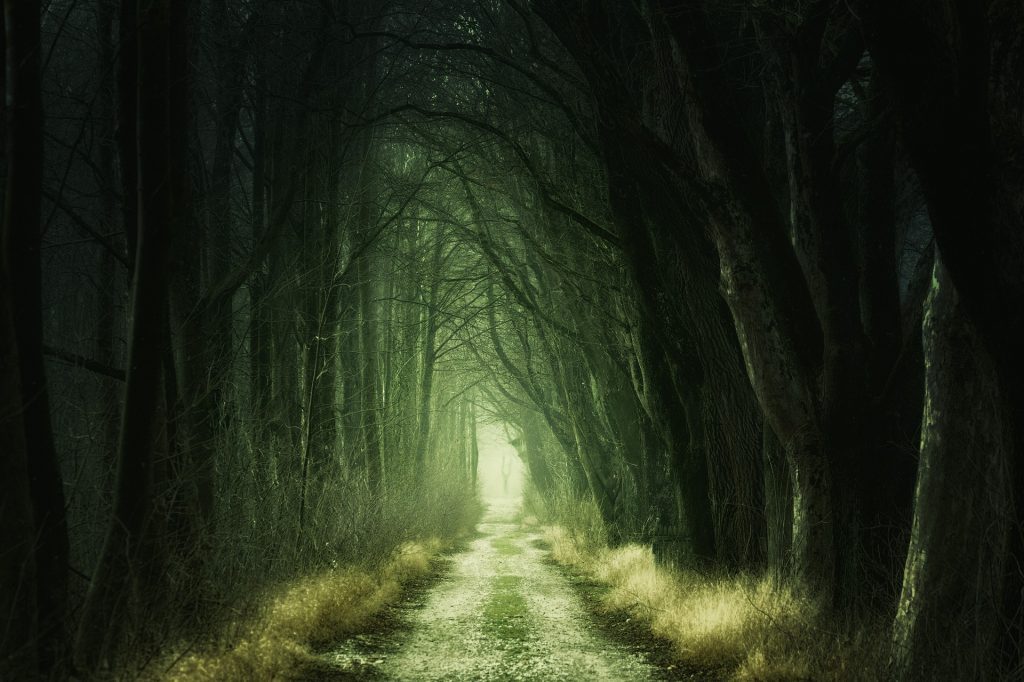
One of the main questions I get regarding the spiritual path is “How do I start?” A lot of people are unsure of where to focus their attention and if they are doing the right thing.
Where a lot of people go wrong is thinking they have to do everything, go down a certain path or practice a specific technique. Instead of just getting started somewhere, they ruminate and get distracted.
In reality, there is no right or wrong on the spiritual path. We might take an approach that isn’t helpful to us and hinders our progress, but the path isn’t linear anyway.
Everything we do with awareness brings us back to ourselves, again and again. It’s a journey of continuously facing yourself – both the light and dark, to find balance.
In this post I’m going to outline some of the ways you can start a spiritual practice, and most importantly, how to keep things simple.
What is the spiritual path?

Before we get into the ways to find your spiritual path, I want to outline what the spiritual path is for those who are somewhat uncertain.
To put it simply, the spiritual path is a journey of reconnecting with our spirit. The spirit is the non-physical aspect of ourselves, our higher self or soul. It’s the part of us that exists beyond physical time and space, beyond human descriptors (although we try our best).
In this modern world, disconnection from spirit is the norm. We might be aware that there is something such as a spirit, or even be interested in spiritual concepts, but for the most part it remain surface level.
A lot of the problems we are currently facing are due to this disconnection from spirit. We aren’t in tune with ourselves and so it’s very easy to become manipulated, feel lost or fearful, and ultimately remain in a state of constant distraction.
To connect with our spirit is to connect with ourselves outside of labels and social roles, identity, outside of the ego. We may call it a spiritual path but really there is no straight line to our spirit.
Our spirit is already here, within us, beyond us, it isn’t really confined to one dimension or one description (specifically using language). So the spiritual path is really one of reconnection, to release the layers we have built between our human self or identity and our spirit.
As we walk the spiritual path it’s about bringing all of these disjointed aspects of ourselves together as one. The ego and spirit, the shadow and light, the fear and peace. Spirituality is a practice of cultivating wholeness.
8 signs you are going through a spiritual awakening
A spiritual awakening usually comes about as a sudden realization or awareness that you are more than the physical; in contrast to a world or society that prioritizes or only acknowledges the physical.
Awakening to this all at once, is incredibly disorienting and uncomfortable.
Not everyone can pinpoint the exact moment when they awoke spiritual or when the spiritual path called to them, for some it’s more of a gradual introduction, like slowly walking into a cold pool of water, rather than jumping straight in.
- You feel the presence of something bigger than yourself
- You look at religion or spirituality in a renewed light
- ‘Regular’ life no longer feels as meaningful
- You are being drawn to spiritual/mystical information
- The work, sleep, eat, repeat cycle no longer interests you
- You feel drawn to make shifts in your lifestyle (diet, exercize, introspection)
- You are experiencing spirit through symbols, signs, synchronicity
- You can feel or sense subtle energy
These signs aren’t just present at the beginning of an awakening, although they are generally more pronounced and come together in a shorter span of time at the start. As we walk our spiritual paths there will be many awakenings, which don’t really stop, we just become more comfortable facing the unknown.
When you feel you’re regressing or circling back on yourself remember, the way out is through.
Pick a spiritual practice calls you

There are so many different spiritual paths and techniques out there that it can become overwhelming when you are just starting out.
Questions you might have: Do you follow a specific spiritual path or play things by ear? Do you focus on meditation, breathwork, prayer, yoga, astrology, tarot cards or something else? Are you practising in the right way?
The thing is, it’s not about what you pick but how you focus your awareness. Spirituality is not contained in or confined to a single practice, it’s within us and in turn, within whatever we focus our attention on.
This is a process of getting in tune with your spirit, and so allow your spirit to lead the way. Which discipline or practice calls to your soul? This is a great first step because you have to tune into your intuition versus following what someone else says.
It’s also important to realize that your spiritual practice doesn’t have to look spiritual, it’s not about surface-level appearance. You don’t have to own tarot cards, a yoga mat, collect crystals or even meditate consistently.
If you love to dance, write, draw, garden, workout, whatever it is, your spiritual practice can come into that.
One of the ways I like to practice spirituality (awareness) is through washing the dishes! This is where I started. No fancy guidelines or tools needed. I get my soap, turn on the water and get to work.
While I’m doing this I remain mindful: How do I feel during this activity? What thoughts are coming up? How mindful am I being doing an activity which isn’t exactly fun or interesting? What resistance do I face?
It’s not about the activity you are doing, but the act of observing yourself through it. It’s easier to get started when the activity in question isn’t complex. We’re not worried about the details but simply on the task in hand.
This activity is what you connect with yourself through, the repetitive actions create a kind of mirror, a pool of water that you see your reflection in. Even meditation can be seen as a repetitive practice, and it can feel like that at first; there isn’t a lot of bells and whistles.
It’s through coming back to that activity day after day, moment to moment, and pushing through the resistance, that you learn things about your being and as an extension, how you approach life. Spiritual practices are like an aperture that gradually expands over time.
Setting roots

Once you picked one area/practice you’d like to focus on it’s time to set some roots.
You want to create the type of space and routine which will help you grow spiritually. We all have different environments and circumstances, so it’s about using what you have. You might no have as much time on your hands, your space might not be as big as you would like it to be and the people you are surrounded by might not be supportive. Remember, it’s not really about those things.
- Create a sacred space
- Keep a journal
- Look for guides/teachers
- Connect with like-minded people
Two things you can do to solidify your spiritual practice are: choosing a designated journal where you’ll note your meditations, insights and areas of interest. Creating a sacred space that you can come back to time and time again – it could be a corner in your room or a special chair, it doesn’t really matter.
These two things help make your spiritual practice physical. On the spiritual path it’s very easy to keep everything on a mental level, to intellectualize everything, so having some physical reference point for your work will be incredibly helpful.
Going inward
The next stage on the spiritual path is going inwards, this is where you might like to pick up specific practices and develop specific techniques for yourself.
When you have solidified a practice for yourself and have been committed to it for some time, you’ll have begun to see some patterns in your ways of being – thinking, feeling and doing. This gives insight into where there is deeper work to do.
This is where we come to realize that being on the spiritual path is not all rainbows and butterflies, we also have to face our shadows. I think this is one of the most difficult aspects of awakening spiritually because what we learn about ourselves can throw us off – it’s uncomfortable.
- Looking at how we label ourselves
- Becoming aware of the persona we put on
- Creating boundaries
- Learning to speak our truth
- Looking at our shadows
- Acknowledging the inner child
- Adjusting our lifestyle/social circles
- Cultivating new interests
One of the biggest pieces of advice I can give to anyone on the spiritual path is to welcome change. We often want to remain in the same place on the spiritual path because we want to appear consistent.
However as you deepen your connection to your spirit there is going to be more and more layers that need to be released. Not only in the sense of becoming a whole new person or reaching a state of complete peace or happiness, but in the little things too.
Your outlook on things is going to shift, the techniques you use will change, the type of person you want to become is going to look different to how it does now.
You will also get to a point where your goal isn’t to be spiritual but to just be present with whatever you are doing in the moment. It’s not about chasing an ideal but about being conscious of where you are and the resistance you have toward present circumstances.
Integration

Expanding on the last section: the next phase is a process of integration. This is where you begin to integrate what you have learned on a spiritual level in a physical sense.
Often on the spiritual path we start to compartmentalize all these different aspects of ourselves: the mind and heart, ego and higher self, shadow and light etc. In order to cultivate balance, we have to bring these aspects together.
Your shadow isn’t a distinct part of you that’s hiding away, neither is your ego, your physical life and spiritual life are not separated – everything is one.
It’s common to find that the ego creates this separation between your spiritual practice and everyday normal life. We might approach spiritual practice as a way to feel better than others or to escape our human lives, which is a manifestation of the spiritualized ego.
You become more solidified in your spiritual practice and aren’t so focused on what other people think, defending specific beliefs or comparing yourself to other people on a similar path. You become aware of your more subtle inner conflicts, contradictions and divisions.
You might focus more on grounding, which is a practice of bringing higher energies down to a physical level; integrating spiritual wisdom more holistically. Through this, not just holding spiritual beliefs, but approaching life spiritually.
This is a phase where we might start to feel comfortable sharing what we’ve learned and passing on the wisdom. On the spiritual path there will be many stretches of isolation and solitude, here you will feel more comfortable branching out into the world.
Overall, the spiritual path isn’t a paint by numbers type of arrangement, laying things out like I have done is a simplification. Instead you’re going to find that progress looks much more like a spiral or maze of sorts than a straight line.
Very insightful posts with great info! While I have been on a spiritual journey for my whole life, I had an awakening last year while seeking answers to get though a challenging time and now my whole life has shifted and completely changed for the better. I like what you stated about the path not being linear, it’s so true.